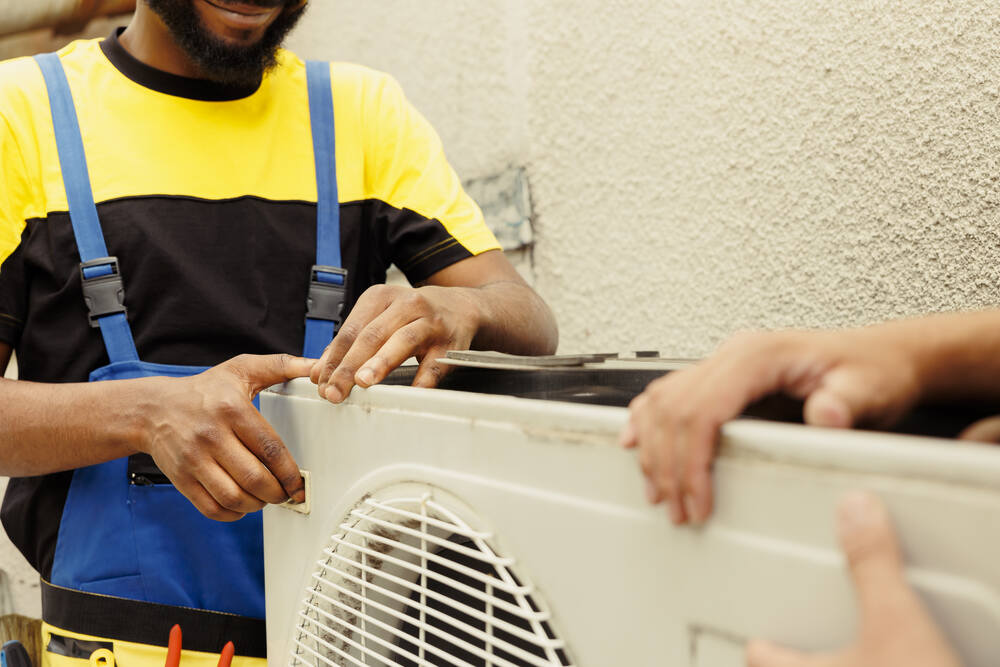Ah, air conditioning: the technology that everyone loves, but few understand. We all rely on AC to keep us cool when the weather turns warm, but most of us couldn’t explain how an air conditioner worked if our comfort depended on it. Well, don’t worry — that’s all about to change. Read our guide to how split AC works below so that you can join the growing ranks of conscientious home and business owners who are better prepared to care for their cooling equipment.
Before we Go into How Split AC Works, Let’s Make Sure You Know What It Is
 We must clear up some basic misconceptions about split AC before we can thoroughly explain the way it functions. For one thing, many people do not understand that split system air conditioners are substantially different from ducted systems. However, it’s essential to realize that these pieces of equipment are not interchangeable and that each requires different forms of maintenance under specific circumstances.
We must clear up some basic misconceptions about split AC before we can thoroughly explain the way it functions. For one thing, many people do not understand that split system air conditioners are substantially different from ducted systems. However, it’s essential to realize that these pieces of equipment are not interchangeable and that each requires different forms of maintenance under specific circumstances.
Ducted systems and split systems are both separated into two distinct units: the indoor unit and the outdoor unit. However, the placement of these units in each variety of air conditioner differs significantly. Ducted systems often have the indoor and outdoor units separated by long tracts of ductwork that spread throughout a home or office. Treated air travels through these ducts and into the rooms that people occupy, supplying them with fresh and cool air to breathe.
In a split system, the indoor and outdoor unit are much closer together — in fact, they are normally only separated by a single wall. This is the main point of difference between ducted and split system air conditioners. Both systems still have compressors, evaporators, condensers, and the rest of the components necessary for completing the cooling cycle. However, the absence of ductwork creates several notable differences regarding air conditioner maintenance (which we’ll explore in a moment).
In a split system AC, the compressor and condenser are both located in the outdoor unit, whereas the evaporator is located inside so that it can make the refrigerant in your system collect heat from the indoor air. The refrigerant lines in split systems are typically made from copper piping instead of hose, which is used in more expansive ducted central systems. The copper piping moves the refrigerant to the outdoor unit where it gives off its heat to the outdoor air via the condenser and becomes compressed so that it can repeat the cycle.
Caring for Split System Air Conditioners
If you’ve been paying attention up to this point, you’ve probably already guessed that split systems don’t require duct cleaning — however, that’s not to say they don’t need careful maintenance, just like any other air conditioner.
Compressors, coils, and refrigerant lines are all sensitive parts that need to be often checked and maintained by professionals. Lines should be examined for leaks, refrigerant levels should be topped up if they drop, coils should be cleaned regularly, and strained compressors should be repaired or replaced. Remember: simply buying a split system AC won’t prevent you from needing service calls by licensed technicians. It will only mean that you don’t have to worry about cleaning your ducts, which is essential for ducted central HVAC systems.
Challenges of Using Split System Air Conditioners
Now that you have a more thorough understanding of how split system AC works, you may start to notice that these units present some unique challenges for their owners. For one thing, the indoor unit must be inside the room you want to be cooled, since you cannot pull air towards the evaporator coils through a series of ducts. That means you’ll have to put a noticeable unit on the wall, which many people find unsightly and inconvenient. Mini-split system air conditioners address this issue by coming in smaller, less-obtrusive sizes, but these have limited cooling efficiency unless they are used to complement larger cooling systems.
Even standard split system air conditioners may not be enough to cool entire buildings. They are typically meant only to provide effective cooling to the rooms in which they are located, making them impractical for use in larger spaces. If you live in a small apartment or work in a building with only one or two rooms, split system air conditioners may be more practical than ducted central systems. In most other cases, it is advisable to consider investing in a central air conditioner instead, since this will provide more even and energy-efficient cooling in a large space.
Now That You Know How Split AC Works, Make Your Own Choice
Learning how split AC works is essential if you’re thinking about purchasing one of these units for your space. Whether you go with a split system or a standard central HVAC, make sure you hire qualified and conscientious people to install it and provide it with the long-term maintenance it needs.
Valley Comfort conducts air conditioning installation services in the following communities: Santa Rosa, Napa, Rohnert Park, Healdsburg, St Helena, Calistoga and Windsor
FAQ: How Does Split AC Work?
1. Why is split AC more energy-efficient than traditional systems?
Split ACs are energy-efficient because they use inverter technology, which adjusts the compressor speed based on cooling needs. Unlike traditional systems that cycle on and off, split ACs maintain a steady temperature, reducing energy waste. Did you know split ACs can cut energy costs by up to 30%?
2. How does a split AC improve indoor air quality?
Split ACs often come with advanced air filters that trap dust, allergens, and even bacteria. These filters purify the air as it circulates, making your indoor environment healthier. For instance, HEPA filters in some units can remove up to 99.97% of airborne particles.
3. Can a split AC cool multiple rooms efficiently?
Yes, but only with a multi-zone system. These systems use one outdoor unit to connect several indoor units, allowing independent temperature control in each room. It’s like having a personalized climate zone for every space. However, the cooling capacity depends on the size and layout of your home.
4. What’s the average lifespan of a split AC?
Most split AC systems last about 12–15 years with proper maintenance. Regular cleaning, timely refrigerant top-ups, and professional servicing can extend their lifespan. Neglecting maintenance, however, can reduce efficiency by 20% or more within the first five years.
5. Is a split AC better for small apartments?
Absolutely! Split ACs are perfect for small spaces because they don’t require ductwork. Plus, their compact indoor units save space and blend seamlessly with modern interiors. Compared to central HVAC systems, they’re 25–40% more cost-effective for single-room cooling.
6. Do split ACs work in cold climates?
Yes, but only if they include a heat pump. Heat pump-equipped split ACs can efficiently heat spaces in winter by reversing the refrigeration cycle. They can operate in temperatures as low as -15°C (5°F), making them versatile for year-round use.
7. What’s the cost of running a split AC per hour?
Running costs depend on factors like the unit’s energy rating, room size, and usage time. On average, a 1.5-ton split AC with a 5-star rating costs around $0.20–$0.40 per hour. Using energy-saving settings can lower this even further.
8. How does a split AC reduce noise levels?
Split ACs are quieter because the noisy compressor is located outside, away from living areas. Indoor units operate at sound levels as low as 19 decibels—quieter than a library! This makes them ideal for bedrooms and workspaces.
9. What refrigerants are used in split ACs, and are they eco-friendly?
Modern split ACs use eco-friendly refrigerants like R-32 and R-410A. These options have lower global warming potential (GWP) compared to older refrigerants like R-22, which is being phased out. Always check the refrigerant type before purchasing.
10. What’s the difference between a split AC and a window AC?
Split ACs offer better cooling efficiency, quieter operation, and a sleeker design compared to window units. While window ACs are cheaper upfront, split systems are more energy-efficient and cost-effective in the long run. A study shows split ACs can save up to 40% on energy bills annually.



